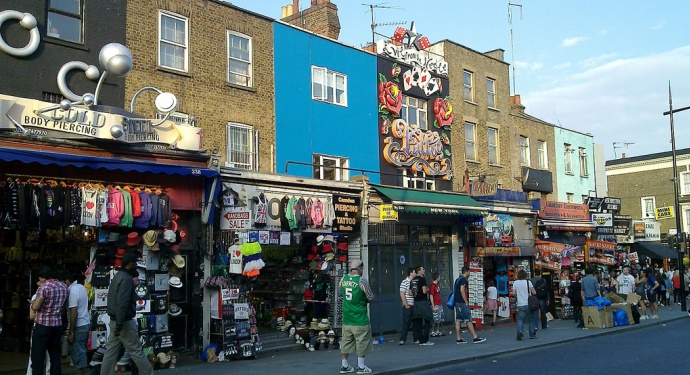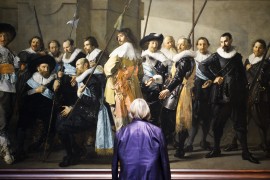From Beatlemania to Girl Power, London’s (and Britain’s by association) music legacy is nothing short of titanic. We’ve rounded up some of the top spots in the capital to discover the haunts of The Beatles, The Sex Pistols, David Bowie, Amy Winehouse and many more of music’s greats.
Camden Town, NW1

You may know it better for London’s busiest market, but Camden is also the after-hours home of the music industry. Camden’s musical links go back to the 1960s, when a counter-culture landmark, named the Roundhouse, became a major venue for some of rock ‘n roll’s biggest names. Over the years Camden’s scene only grew bigger and the world’s greatest musicians have all played here – from Bob Dylan to Nirvana, The Clash and Madonna. Reggae legend Bob Marley, lived in the area in 1972; and pop-icon Prince owned a boutique in Camden in the early 1990s. More recently, Amy Winehouse, the late North London-born singer, was bestowed a life-size statue which stands proudly at the heart of Camden’s very own Stables Market. Today Camden Town is still breaming with music venues big and small – showcasing promising musicians of all musical genres, from jazz to punk rock.
Pick up the musical vibe – Join one of the many gigs in the mythical venues around Camden, such as the Roundhouse on Chalk Farm Road, the Electric Ballroom on Camden High Street, KOKO (formerly know as The Camden Palace), or The Jazz Cafe. And be sure to check out the autographed rock star hall of fame at The Hawley Arms, Amy Winehouse’s local back in the day.
Abbey Road, NW8

Abbey Road in St John’s Wood is both synonymous with the 1969 Beatles album, and the recording studios, formerly known as EMI studios. Built in 1931 by the Gramophone Company (later known as EMI), the Abbey Road studios hit international fame in the 1960s, by introducing innovative recording techniques which were adopted by famous musical acts at the time such as The Beatles, Pink Floyd, the Hollies and others. But it was in August 1969, when the Fab Four left the studios for a 10-minute photo shoot on a nearby zebra crossing, that Abbey Road would be bestowed superstardom. To this day thousands of Beatles’ fans still visit the leafy northern suburb to walk across Abbey Road, and have their photo taken while trying to recreate the infamous album cover.
Pick up the musical vibe – Besides having your picture taken at the zebra crossing, step inside the famous Abbey Road studios on a virtual tour, courtesy of Google.
Carnaby Street, W1F

From nightclubs to clothes stores, recording companies and music magazines, Carnaby and the 12 other streets that surround it, have long attracted generations of musicians and their fans. In the 1930s there were 6 or 7 Jazz clubs in different basements along Kingly Street; one of these, ‘The Nest’, hosted some of the Jazz greats of the era. Decades later, in the 1960s, Carnaby proved particularly popular for followers of both the Mod and Hippie styles, with many boutiques and underground venues such as The Roaring Twenties (now a Ben Sherman shop) or the legendary Marquee Club opening up. The Who, Jimi Hendrix and The Rolling Stones all appeared in the area to work, shop, and socialise. And in the 80s Boy George worked as a window dresser at The Foundry, a clothes shop which sold designs worn by bands such as the Cure, Culture Club and Bananarama.
Pick up the musical vibe – The Bag ‘O Nails, located on 9 Kingly Court, is one of the few surviving historical clubs in the area. Starting off as a Jazz venue in the 30s, this nightclub was Jimi Hendrix’s first London gig, and became a hangout for musicians such as the Beatles or Eric Clapton. It was here that Paul McCartney first met his first wife, Linda. To find out more on the musical history of Carnaby, visit the Carnaby Echoes website.
Denmark Street (Tin Pan Alley), WC2H

Known to Londoners as ‘Tin Pan Alley’, due to a high concentration of music shops, Denmark Street is historically one of the most important locations in London for the music industry. The street’s glory days were mainly in the 60s, when musicians would shop for instruments in between visiting publishers or recording in one of its legendary studios. The Rolling Stones and The Kinks came here, so did Donovan and Jimmy Page, Black Sabbath and Jeff Beck. At number 20, a young Elton John worked as a tea boy in a publishing company, and David Bowie was said to practically live at La Gioconda, a café/bar in which many songwriters, musicians and publishers used to hang out. In later years, the street began to slowly decline in importance – although the upper floor of number 6 served as a rehearsal space for The Sex Pistols at some point. More recently, both Keane and Adele have been known to play at number 26, long before international stardom.
Pick up the musical vibe – Even though Denmark Street still features rehearsal rooms, studio spaces, music publishers, venues, and guitar shops, in recent years the area has been facing the pressures of the booming London property market. There is currently a petition, supported by many famous musicians, which aims to save London’s Tin Pan Alley from developers. Find out more on the Save Denmark Street website.
Chelsea, SW3

Although Chelsea and its neighbouring areas are now like London’s equivalent to LA’s Beverly Hills or the New York Upper East Side, in the late 70s it was mostly known as the British home of Punk Rock. But the musical roots of Chelsea go as far back as the 1960s, when dozens of shops dedicated to the latest fashion were opened around the World’s End district. The area was also home to the likes of Mick Jagger, Keith Richards and Eric Clapton at the time. In the late 70s impresario Malcolm McLaren returned from the US and brought with him radical new designs for a clothes store, which he would run with fashion designer Vivien Westwood on Kings Road, under the name ‘SEX’. It was here that the members of British Punk Rock band The Sex Pistols first met. Taken under McLaren’s wing, The Sex Pistols soon became the figureheads of the British Punk scene and a symbol of rebellion against the conservative government of Margaret Thatcher. Other famous customers at the store included vocalist Siouxsie Sioux of Siouxsie and the Banshees, and Chrissie Hynde of The Pretenders.
Pick up the Musical Vibe: Re-opened in the 1980s under its new name World’s End, the former punk shop is still open to the public on 430 King’s Road and is part of Vivienne Westwood’s global fashion empire.
Where to Stay
On a budget
The Fox and Goose is a traditional hotel with a typical English pub, located in the heart of Ealing, West London. With stylish bedrooms, featuring modern en-suite bathrooms, air conditioning, flat screen TVs and free Wi-Fi, the Fox and Goose is ideally located for Hanger Lane underground station (Central Line), taking you to Central London in no time. From £69.
Splurge a little
One of London’s most well-known boutique hotels, The Portobello Hotel was founded in 1971 and, ever since, has been THE hotel for those in the know from the world of music, show business and fashion, hosting many famous faces over the years. Each of the 21 bedrooms are individually designed and include complimentary Wi-Fi, organic teas, Nespresso machine, complimentary water and a selection of magazines. From £195 including breakfast.
Image Credits:
Abbey Road Sign (feature image) – Image by David~ via Flickr (CC BY 2.0)
Camden Town – Image by mtarvainen via Flickr (CC BY-ND 2.0)
Abbey Road (black and white) – Image by MrJamesAckerley via Flickr (CC BY-NC 2.0)
Carnaby Street – Image by Matt Gillman via Flickr (CC BY 2.0)
Denmark Street guitar shop – Image by Freebird via Flickr (CC BY-SA 2.0)
Chelsea – Image by Kings Road via Facebook







